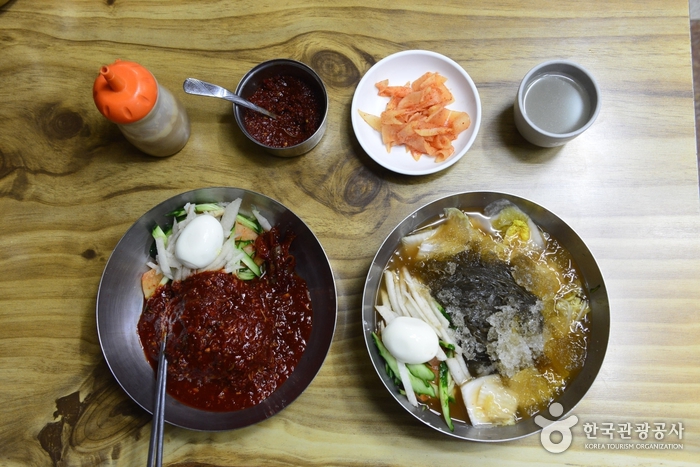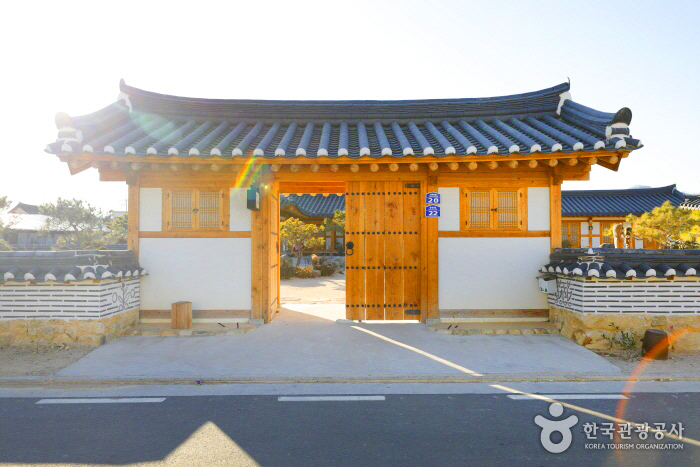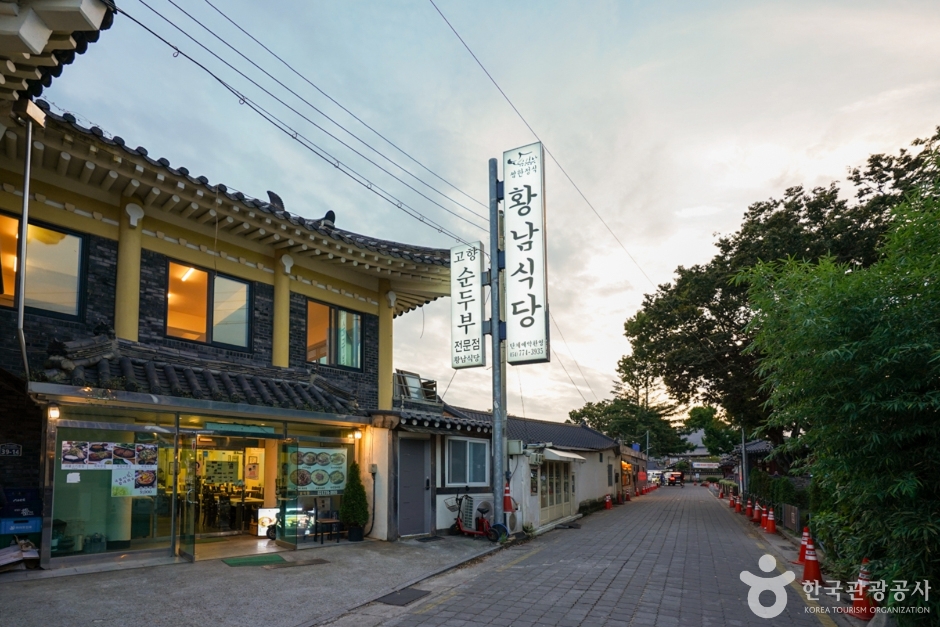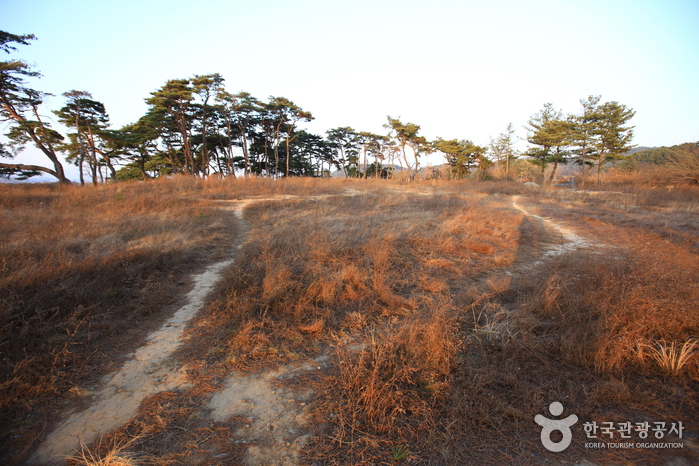Second Face - Gyeongju Branch [Tax Refund Shop] (세컨페이스 경주)
16.9Km 0 2024-04-18
1F, 101, Gyerim-ro, Gyeongju-si, Gyeongsangbuk-do
-
Pyeongyang Naengmyeon (평양냉면)
16.9Km 9641 2017-01-19
109-2, Wonhyo-ro, Gyeongju-si, Gyeongsangbuk-do
+82-54-772-2448
The restaurant of Pyeongyang Naengmyeon has been operated through two generations and thus is very famous in Gyeongju. Its noodles are hand-made from starch of Korea-grown buckwheat and potato and broth is made by deeply boiling beef bones. So, noodles are chewy and broth tastes rich and clean.
Hwangseong Park (황성공원)
16.9Km 28363 2024-02-23
431-12 Wonhwa-ro, Gyeongju-si, Gyeongsangbuk-do
Situated near the Gyeongju Municipal Library and Gyeongju Arena, Hwangseong Park is notable for its dense forest populated with stunning pine trees and centuries-old trees. During summer, it becomes a haven for blooming Lilyturfs, while in autumn, ancient trees such as zelkova and oak showcase vibrant colors, enhancing the natural beauty of the area. Within the park, visitors can find the Statue of General Kim Yusin, a Korean archery range, and a Ssireum (Korean traditional wrestling) ring. Nearby attractions include Gyeongjueupseong Walled Town, Cheonmachong Tomb, Daereungwon Ancient Tombs, and Hwangnidan Street.
Gyeongjuhanok 1st [Korea Quality] / 경주한옥1번가 [한국관광 품질인증]
16.9Km 949 2023-10-25
20 , Cheonwon 1-gil, Gyeongju-si, Gyeongsangbuk-do
+82-10-9505-5367
Standing at the entrance of Cheonwon Village in Gyeongju, Gyeongsangbuk-do, Gyeongju Hanok First is a hanok stay combining the beauty of tradition with modern convenience. All rooms are Korean-style with comfortable bedding on the floor, and all have a toilet and bathroom. One guestroom has its own kitchen, while the others have basic cooking facilities in a shared kitchen. The spacious yard is decorated with figurines in traditional clothes. Nearby tourist attractions include Anapji Pond, Cheomseongdae Observatory, and Gyeongju Museum.
Wadamjung (와담정)
17.0Km 814 2024-08-01
18 , Cheonwon 1-gil, Gyeongju-si, Gyeongsangbuk-do
+82-54-772-5400, +82-10-6571-3412
Wadamjeong in Cheonwon Village, Gyeongju, Gyeongsangbuk-do, is a hanok pension combining traditional style and atmosphere with modern convenience. All rooms have air-conditioning/heating and a bathroom with toilet. The stand-alone guestroom has its own kitchen, while other rooms have basic cooking facilities in a shared kitchen. In the spacious yard - decorated with traditional landscape scenes - visitors can try out traditional games such as Jegi (shuttlecoks) and Tuho (arrow-throwing). Historic sites such as Cheomseongdae and the Gyeongju Museum are all nearby.
Gyeongju Historic Area [UNESCO World Heritage] (경주역사유적지구 [유네스코 세계문화유산])
17.0Km 55544 2022-05-11
757, Taejong-ro, Gyeongju-si, Gyeongsangbuk-do
+82-54-779-6100
The Gyeongju Historic Area, registered as a UNESCO World Cultural Heritage on November 2000, is an area that embodies the time-honored history and culture of Gyeongju, the ancient capital of the Silla Kingdom (57 BC-AD 935).
The Gyeongju Historic Area can be divided into 5 major sections. The first section is the Namsan Area, a treasure trove of Buddhist art masterpieces dating back to the Silla Kingdom. Gyeongju Namsan Mountain (often referred to as an ‘outdoor museum’) is home to many historical heritage sites from the Silla Kingdom. Major attractions include: Poseokjeong (Historic Site No.1), Tapgok Maaejosanggun (Treasure No. 201), Cheollyongsaji Three-story Stone Pagoda (Treasure No. 1188), Chilbulam Maae Stone Buddha (Treasure No. 200), Bulgok Seated Stone Buddha (Treasure No. 198), and 37 other Buddhist relics
The second section is the Wolseong Area, one of the former palace sites of the Silla Kingdom. The area consists of Gyerim (Historic Site No. 19); Donggung Palace and Wolji (Historic Site No. 18), a Silla Royal Palace site; and Cheomseongdae (National Treasure No. 31), the oldest observatory in the East. Daereungwon area, the third area, features a cluster of the royal graves of the Kings and Queens of Silla.
Also in the same area are Gobungun (a cluster of old graves) in Nodong-ri (Historic Site No. 38), Gobungun (a cluster of old graves) in Noseo-ri (Historic Site No. 39) Gobungun (a cluster of old graves) in Hwangnam-ri (Historic Site No. 40), and Oreung (Historic Site No. 172), among others. Archaeologists have discovered a number of invaluable relics and historic items in this area such as Geumgwan (golden crown), Cheonmado (a painting of flying horses), and numerous pottery pieces. These finds are perhaps the greatest clues into the life of the people of the Silla Dynasty.
Area number four, the Hwangnyongsa Area, is where the former site of the Hwangnyongsa Temple (Historic Site No. 246) and Bunhwangsa Stone Pagoda are located. Lastly, is the Sanseong Area, housing remnants of the major defense system for the capital city. The site consists of Myeonghwalsanseong Fortress (Historic Site No. 47) which is estimated to be around 400 years old.
The Gyeongju Historic Area has a total of 52 designated cultural assets that are registered as World Cultural Heritages.
Hanokinn [Korea Quality] / 한옥人(한옥인) [한국관광 품질인증]
17.0Km 3 2024-07-01
19 , Poseok-ro 1050beon-gil, Gyeongju-si, Gyeongsangbuk-do
+82-54-749-8090
The Hanok Inn is a hotel-class traditional guesthouse in Sansu-dong, Gyeongju, Gyeongsangbuk-do, which consists of 4 separate buildings. The sarangchae - a two-story hanok with a hipped roof - contains a double room and a large family room, finished with red clay and hanji paper; both rooms have toilets. The annex building is a one-storey gable-roofed hanok with a raised wooden patio where guests can drink tea and relax. In the main building there’s a hanok experience room and a friendly cafe-restaurant where breakfast is served. The hanok’s back gate gives onto an alley leading to Hwangnidan-gil, Cheomseongdae Observatory, and the Daereungwon tomb complex; this alley is a favorite photo spot.
Gyeongju Ssambap Street (경주 쌈밥거리)
17.1Km 0 2024-02-08
9 Gyerim-ro, Gyeongju-si, Gyeongsangbuk-do
Gyeongju Ssambap Street, developed around the Daereungwon Ancient Tombs in Gyeongju, offers a diverse culinary experience. A highlight is ssambap (leaf wraps and rice), a dish featuring fresh vegetables accompanied by substantial side dishes like fish, meat, and doenjang jjigae (soybean paste jjigae) made from homemade soybean paste. Additionally, this street presents a variety of snacks, including Hwangnam ppang (Hwangnam bread) prepared with red beans and flour, and jjondeugi, a traditional chewy snack made from cornmeal and sugar. Nearby attractions include the Cheomseongdae Observatory, Donggung Palace and Wolji Pond, Woljeonggyo Bridge, and the Gyeongju National Museum.
Gyeongju Daereungwon Ancient Tomb Complex (경주 대릉원 일원)
17.1Km 13734 2022-12-26
9, Gyerim-ro, Gyeonju-si, Gyeongsangbuk-do
+82-54-750-8650
Gyeongju Daereungwon Tomb Complex consists of five tombs, Ancient Tombs of Gyeongju Nodong-ri, Noseo-ri, Hwangnam-ri, Hwango-ri, and Inwang-ri. The tombs are distributed in Hwangnam-dong, Gyeongju-si, and are located in the Daereungwon area. Within Daereungwon Tomb Complex is Cheonmachong Tomb, which was excavated in 1973. Furthermore, Hwangnamdaechong Tomb was excavated between 1973 and 1975, and is a set of twin tombs belonging to a presumed married couple.
Gyeongju Najeong Well (경주 나정)
17.1Km 12765 2020-04-06
Tap-dong, Gyeongju-si, Gyeongsangbuk-do
+82-54-779-6100
To the southeast of the royal tomb, is a small monument that has been erected among the pine trees; next to the monument is a well called Najeong. According to Samguksagi (Historical records of the Three Kingdoms) and Samgungnyusa (Memorabilia from the three dynasties), Park Hyeokgeose, the founding monarch of Silla, was born by this well. In 69 BC, Sobeolgong, the head of Goheochon Village, saw a white horse on its knees by the well. When he approached the well he found that the horse had magically disappeared and that a large egg was left in its place, from which a boy was born. When the boy turned 13 years old (57 BC), he was appointed king by the village chiefs and began to rule the area then called ‘Seorabeol’. A memorial stone (2.25 meters high, 45 centimeters long, and 21 centimeters wide) was erected in 1803 in the third year of King Sunjo's rule (Joseon dynasty) detailing the historical origins of the founding father of Silla.
![Second Face - Gyeongju Branch [Tax Refund Shop] (세컨페이스 경주)](http://tong.visitkorea.or.kr/cms/resource/47/2883747_image2_1.jpg)


![Gyeongjuhanok 1st [Korea Quality] / 경주한옥1번가 [한국관광 품질인증]](http://tong.visitkorea.or.kr/cms/resource/15/3021415_image2_1.jpg)

![Gyeongju Historic Area [UNESCO World Heritage] (경주역사유적지구 [유네스코 세계문화유산])](http://tong.visitkorea.or.kr/cms/resource/03/2656603_image2_1.jpg)
![Hanokinn [Korea Quality] / 한옥人(한옥인) [한국관광 품질인증]](http://tong.visitkorea.or.kr/cms/resource/65/2707565_image2_1.jpg)


 English
English
 한국어
한국어 日本語
日本語 中文(简体)
中文(简体) Deutsch
Deutsch Français
Français Español
Español Русский
Русский